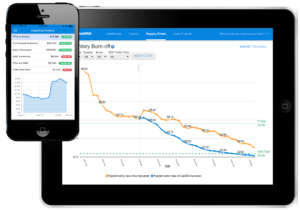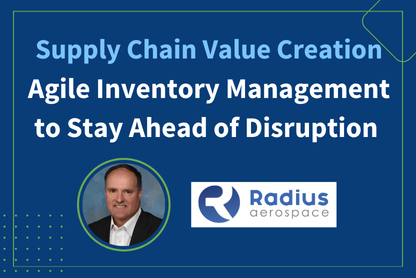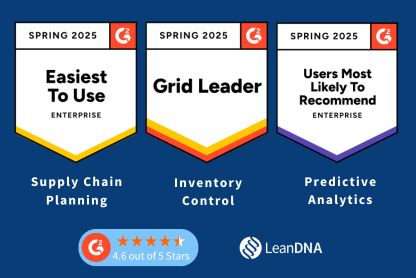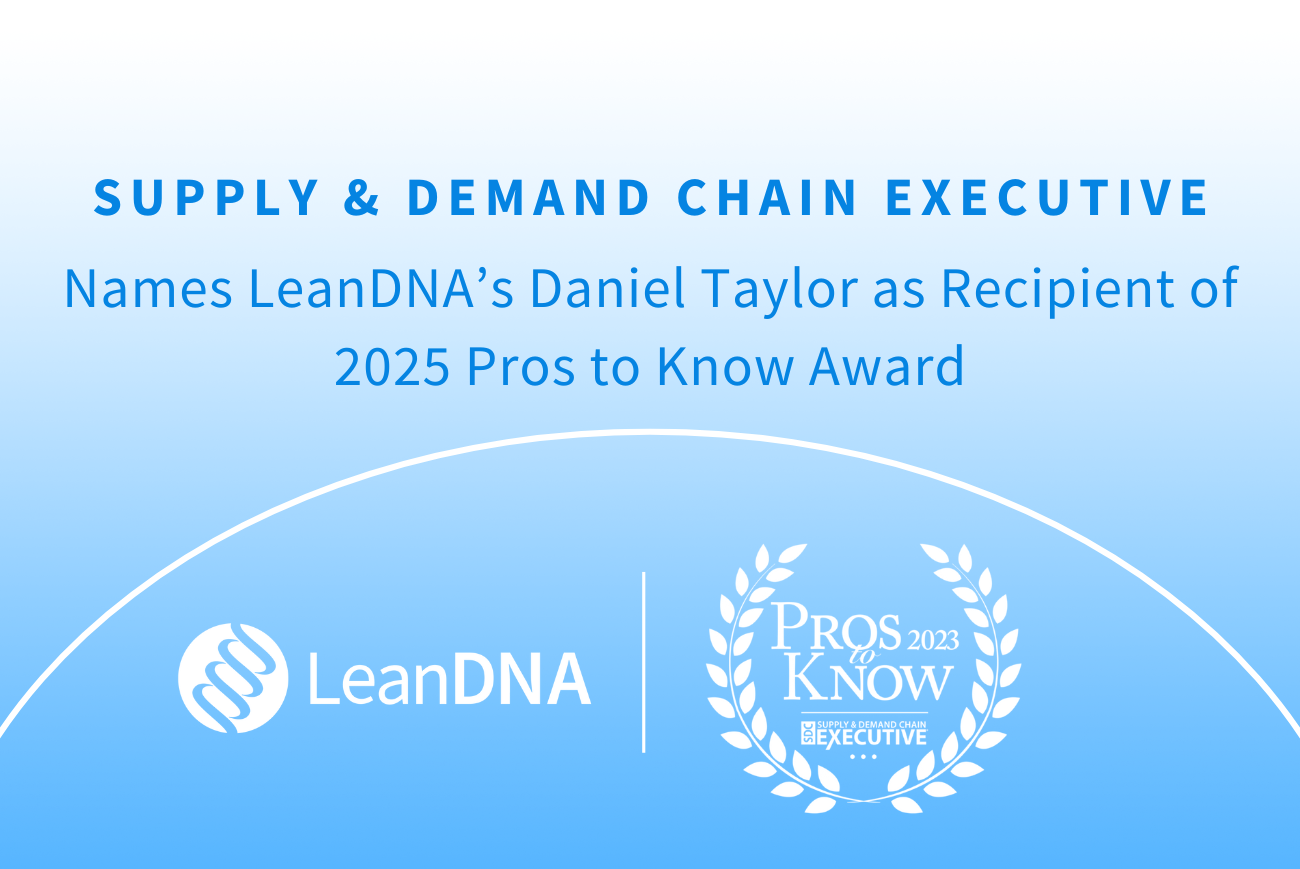How Can Plan for Every Part (PFEP) Help Optimize My Supply Chain?
As supply chains grow increasingly complex, it can feel impossible to understand how to assess and optimize inventory from end to end. Supply chain leaders, already tasked with the daily responsibilities of firefighting through shortages and ballooning inventory, also have compounded responsibilities to guarantee sustainable on-time delivery over time.
However, inventory data collection is often tedious and manual, and it can take weeks, if not months, to complete. And as soon as it’s analyzed, the inventory data may already be out of date. And while ERPs can hold all of that inventory data, they require expensive, manual, and time-intensive maintenance to keep up to date. Without a simple, structured process for routine inventory data updates, it’s even harder to see and act on opportunities for improvement in the factory.
That’s why lean manufacturers introduced the Plan for Every Part (PFEP). As your team develops inventory optimization goals to reduce shortages, improve working capital, and ultimately maximize production throughput, your PFEP can help you prioritize opportunities that can create the biggest impact in end-to-end inventory management. Instead of churning through noise to look for exceptions, your team can instead efficiently manage the outliers that most affect your supply chain.
What Is a Plan For Every Part (PFEP) and Why Is It Important?
PFEP optimizes the policies that define how to procure each part. A PFEP is a competitive weapon that enables supply chain leaders to glean a 360-degree view of their inventory and procurement policies to make sure each inventory dollar is maximized. Ultimately, the end-goal of creating a PFEP is to help you right-size your inventory as fast as possible without running into parts shortages that may hinder production time.
When Your Factory ERP is Stalling, PFEP Can Help
Even with the regular maintenance included in your ERP’s services, you still need to maintain all of the information you put into the system. This is easier said than done. Daily critical issues can get in the way of regular maintenance and upkeep of ERP data and order policies.
This daily firefighting can come in the form of:
- Expediting purchase orders (POs)
- Addressing critical shortages on some parts and bloated inventory on others
- Safeguarding against shifting demand and sales forecasts
Look familiar? Your PFEP not only helps you create policies that ensure your ERP’s longevity but also helps buyers and planners work proactively to optimize the supply chain. Instead of letting reactive issues get in the way of company goals, why don’t we implement repeatable processes and standard data analysis tools to ensure our ERP systems’ longevity in the first place?
Plan for Every Part Keeps Your ERP at its Best

A PFEP can soothe countless pains, from critical shortages to ballooning excess and obsolete (E&O) inventory.
The first step to operationalizing and reap the rewards of your PFEP is to ensure the challenges you’re trying to solve align with your teams’ goals. If you don’t have the process set correctly, then you’ll either feel like you didn’t get the right results or, if you did get them, that it took a huge amount of manual intervention. So, take a step back and say, “Let’s get our system optimized upfront,” and then manage only the exceptions going forward.
Once your teams are aligned on priorities in optimizing inventory levels, there are three critical steps to creating a PFEP:
Plan and Collect Supply Chain Data
The first step is to gather your inventory data and begin to plan for every part. This task can be laborious, but a lot of your part-level raw data is already stored in your ERP system. The foundation of planning is reliable, standardized data that your whole team can see in one place, making this the hardest step of creating your PFEP.
Many supply chain leaders start this process by going into their ERP systems, exporting the data to Excel, and analyzing their data manually. But exporting a data set that large makes it difficult to do analysis easily and frequently. Often, consulting firms will simply dump your system into a spreadsheet without validating or scrubbing the data. (Spoiler alert: Bad data still yields bad results.)
The problem with running this process in Excel is that supply chain data is often static. Have you ever written an email asking, “Who has the latest version of this?” Data cleansing and supply chain visibility tools can break down your team’s data silos, empowering them to start with a single source of truth and develop the skills to resolve supply chain problems without pulling in consultants or additional team members. Consider using these tools to simplify and accelerate your data-gathering process.
Once you can see all of your clean supply chain data in one place, you can analyze a complete picture of your inventory data, instead of managing the information in disconnected Excel spreadsheets or across multiple ERP systems. This not only helps optimize inventory levels for individual factories but can also give your team true operational command to impact supply chain KPIs across your organization if you have the power to integrate your ERP data across multiple sites.
Here’s What You Need to Know to Create a PFEP:
- ABC Classification (product-quantity [PQ] analysis)
- XYZ Rank (demand variability analysis)
- Master Data such as item-level lead time, lot size, supplier, buyer, product line, minimum order quantity (MOQ), and more
Technology Tip: Consider an automated system designed to deal with supply chain data analytics on a large scale. Emerging web-based applications can now thoroughly analyze your ERP data so your team can collaboratively identify, flag, assign, and resolve any discrepancies. The key is to easily flag opportunities where your inventory data can be improved so your supply chain analysis can be more robust.
Analyze Inventory Data and Document Processes
The second step in your PFEP process is to manipulate your supply chain data. You could turn to manual methods (read: clunky, antiquated, static) like Excel to create custom logic using rules and formulas to understand and classify your data. Newer, improved methods use AI and machine learning to crunch the numbers. Automated algorithms and AI can be key to ensuring you are using the most up-to-date data at any given moment.
To Analyze Your PFEP:
- Find deviations in current settings vs. ideal settings:
- Look at your safety stock levels for each site, especially for A items. Do they look too low or inflated? If so, systematically ensure that your safety stock could cover a potential disruption.
- Review and adjust incorrect order policies and POs to ensure you’re freeing up cash. Be sure to segment them and tackle them in order of your team’s priorities. Ideally, the POs that affect the most capital in your supply chain should be addressed first.
- Ensure your MOQ is sized properly based on current demand.
- Form a plan around your ABC/XYZ analysis and your team’s goals:
- Can you reduce your working capital by eliminating excess and obsolete inventory?
- Can you proactively tackle future shortages that may cost you lost production time and late penalties?
- Document all processes so that others can follow, and repeat them with an outcome that has your company’s goals in mind.
[Learn how to automate your inventory optimization process here.]
Comply with PFEP Best Practices
How strictly is your supply chain complying with the rules put in place from your PFEP? The third step in implementing your PFEP is to put it into practice and refresh your data periodically so it meets your current supply and demand. Once you have total visibility into your biggest opportunities and metrics, it’s easy to take the set-it-and-forget-it approach when operating and updating your ERP systems.
Technology Tip: A yearly or biannual mass ERP update to reflect new procurement policies, demand, and inventory plans isn’t frequent enough, especially in periods when demand fluctuates. Use APIs to your advantage to pull fresh ERP data once every quarter at a minimum and incorporate it into your PFEP.
At a tactical level, it’s a good idea to optimize your ERP day-to-day by prioritizing the top ten or twenty opportunities. Adopt the mentality that these ten things are worth doing immediately because aligning buying practices for those materials with their current changes in demand represents thousands—or even millions—of dollars in savings. The challenge to this final step in the PFEP process is finding an effective way of prioritizing procurement tasks. You want to be able to consistently recognize low-hanging, but impactful, fruit.
Example: Imagine that your star buyer, Brad, needs to cut a PO for three months' worth of raw materials. Your procurement policies suggest he cut three separate POs for each month based on lead time, demand, MOQ, contractual obligations, etc. While talking to a supplier, however, Brad agrees to cut one PO for all 90 days. He just increased inventory by 3x for the sake of convenience! How can you get your buyers to comply with your policies to avoid bloated inventories and free up working capital? (Hint: You can do this through transparency and collaboration driven by lean supply chain optimization tools.)
Develop and Empower Your Supply Chain Team
It’s tempting for many companies to hire consultants in order to optimize inventory processes. However, without visibility into consistently fresh inventory data, these consultants can end up being costly for infrequent results. After spending a few days or weeks chasing down your team’s inventory data, they’re given a very limited and unreliable Excel file filled with unprocessed information. Data is likely missing or inaccurate—which often goes unaddressed by third-party partners.
From here, firms may diverge into various approaches that may not meet your pre-decided goals or standardized processes. This process can leave teams with a costly bill to foot and a feeling of being left in the dark with unvetted ERP data. However, with an easy, best-practice PFEP process in your team’s arsenal, you can keep your ERP updated frequently and accurately.
Technology Tip: The data in your ERP system is invaluable, and for the cost of a week with a consultant, you could purchase a cloud-based PFEP optimization solution for an entire year. There are many supply chain technologies that connect directly to the source of your data and run an automated check into how your system is performing—and offer ways to improve it.
Most importantly, automating your PFEP process helps free up cash in your supply chain and lets team members work on business-critical priorities. For example, before using LeanDNA, supply chain teams at Safran Seats GB manually built out spreadsheet reports, and subsequently, data and insights varied from team to team. The team would spend entire team meetings disputing which spreadsheet was right. Meanwhile, the team could not see their ballooning on-hand inventory levels or mitigate inevitable shortages of critical items. Within three months of implementing LeanDNA, they gained visibility into inventory and were able to take swift actions to optimize inventory levels. As a result, the team was able to reduce inventory by 36 percent and free up working capital in its supply chain. [Calculate how much you can save by making smarter, faster, more profitable inventory decisions.]
Help Your Team Meet Inventory Reduction Goals
You’ll know when your PFEP is running smoothly when you achieve improved on-time delivery, little to no shortages, and reduced inventory waste with far less manual intervention. While disruptions and exceptions are bound to happen, it’s imperative to find certainty in your own data and move with agility to tackle the most critical issues that stand before you. With fresh and reliable data, improved visibility into every part, and a plan to tackle your most pressing business priorities, your PFEP can help you save cash, improve on-time delivery, and make your customers even happier.
Can Small Order Policy Readjustments Lead to Big Savings?
Your PFEP gives you visibility into your most critical inventory issues so you can take action on them. Download Make Smarter Inventory Decisions With a Daily PFEP to get step-by-step instructions on how to create a PFEP and learn best practices to free up working capital in your supply chain.
Having trouble optimizing your Plan for Every Part best practices?
The problem may lie in your ABC-XYZ Analysis. Both the ABC classification and XYZ rank are necessary steps for creating an optimal PFEP, but supply chain teams cannot get the most out of these reports without fully understanding how to classify parts under these rankings.
The ABC analysis puts items into three categories: ‘A’ which are high usage or high price items (or both), ‘B’ or lower priced items, and ‘C’ items which account for the least amount of your inventory value.
An XYZ analysis also divides the items into three distinct categories: ‘X’ items have very little demand variation, ‘Y’ items have fluctuations in demand, and ‘Z’ items have the highest demand variation.
Want to automate your ABC-XYZ analysis or PFEP practices?
LeanDNA uses historical data to automatically generate ABC-XYZ reports using a comprehensive Plan for Every Part strategy.
Learn more about the advantages of LeanDNA’s inventory optimization and daily automation




